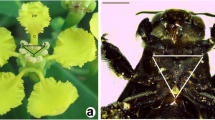Abstract
Stigma morphology was examined with the SEM in 14 of the 16 species ofVillarsia. In nine of the ten distylous species studied, stigmas of the floral morphs were strongly dimorphic in length, shape, configuration of the receptive surface, and in the size and density of their papillae. Thrum stigmas ofVillarsia, in contrast to those of most other distylous species, are not simply smaller versions of the conspecific pin stigmas, but generally exhibit an array of morph-specific characters. Thrum stigma lobes may be broader than those of pins, they may have undulate margins, lobes subdivided into secondary lobes, papillae more extensively distributed than in pins, and various combinations of these traits occur. The traits that distinguish thrum from pin stigmas achieve an increase in the receptive area and may enhance more efficient pollen capture by the shorter and less accessible thrum stigmas. The morphogenesis of the stigma shape dimorphism appears to involve processes more complex than inhibition of elongation in thrum styles. InVillarsia, the stigma dimorphisms are species-specific. No correlations were found between morphologies of the stigma and the different breeding systems in distylous species. Stigmas of the four non-heterostylous species examined resemble the thrum stigma type found in most distylousVillarsia species.
Similar content being viewed by others
References
Aston H. I. (1969) The genusVillarsia (Menyanthaceae) in Australia. Muelleria 2: 3–63.
Aston H. I. (1973) Aquatic plants of Australia. Melbourne University Press, Melbourne.
Baker H. G. (1956) Studies in the reproductive biology of the West African Rubiaceae. J. West Afr. Sci. Assoc. 4: 9–24.
Barrett S. C. H., Glover D. E. (1985) On the Darwinian hypothesis of the adaptive significance of tristyly. Evolution 39: 766–774.
Barrett S. C. H. (1990) The evolution and adaptive significance of heterostyly. Trends Ecol. Evol. 5: 144–148.
Dahlgren K. V. O. (1918) Heterostylie innerhalb der GattungPlumbago. Svensk Bot. Tidskr. 12: 362–372.
Dahlgren K. V. O. (1923)Ceratostigma, eine heterostyle Gattung. Ber. Dtsch. Bot. Ges. 41: 35–38.
Dahlgren K. V. O. (1970) Heterostylie beiDyerophytum indicum (Gibs. ex Wight) O. K. (Plumbaginaceae). Svensk Bot. Tidskr. 64: 179–183.
Dulberger R. (1975) Intermorph structural differences between stigmatic papillae and pollen grains in relation to incompatibility in Plumbaginaceae. Proc. R. Soc. Lond. Ser. B 188: 257–274.
Dulberger R. (1992) Floral polymorphisms and their functional significance in the heterostylous syndrome. In: Barrett S. C. H. (ed.) Evolution and function of heterostyly. Springer, Berlin Heidelberg, pp. 41–84.
Dulberger R. (1998) Polymorphism of stigmatic papillae density and its possible significance. XVth Intern. Congr. Sexual Pl. Reprod. p. 73. Wageningen Agricultural University, The Netherlands.
Ganders F. R. (1979) The biology of heterostyly. NZ. J. Bot. 17: 607–635.
Hermann B. P., Mal T. K., Williams R. J., Dollahon N. R. (1998) Quantitative evaluation of stigma polymorphisms in a tristylous weed,Lythrum salicaria (Lythraceae). Amer. J. Bot. Suppl. Abstracts 85: 9–10.
Hermann B. P., Mal T. K., Williams R. J., Dollahon N. R. (1999) Quantitative evaluation of stigma polymorphism in a tristylous weed,Lythrum salicaria (Lythraceae). Amer. J. Bot. 86: 1121–1129.
Heslop-Harrison Y., Shivanna K. R. (1977) The receptive surface of the angiosperm stigma. Ann. Bot. 41: 1233–1258.
Köhler E. (1973) Pollen dimorphism and heterostyly in the genusWaltheria (Sterculiaceae). In: Ferguson J. K., Muller J. (eds.) The evolutionary significance of the exine. Linn. Soc. Symp. Ser. 1: 147–162. Academic Press, London New York.
Kohn J., Barrett S. C. H. (1992b) Floral manipulations reveal the cause of male fitness variation in experimental populations ofEichhornia paniculata (Pontederiaceae). Functional Ecology 6: 590–595.
Lewis D. (1982) Incompatibility, stamen movement and pollen economy in a heterostyled tropical forest tree,Cratoxylum formosum (Guttiferae). Proc. R. Soc. Lond. Ser. B 214: 273–283.
Lloyd D. G., Webb C. J. (1992) The selection of heterostyly. In: Barrett S. C. H. (ed.) Evolution and function of heterostyly. Springer, Berlin, pp. 179–208.
Ornduff R. (1982) Heterostyly and incompatibility inVillarsia capitata (Menyanthaceae). Taxon 31: 495–497.
Ornduff R. (1986) Comparative fecundity and population composition of heterostylous and non-heterostylous species ofVillarsia (Menyanthaceae) in Western Australia. Amer. J. Bot. 73: 282–286.
Ornduff R. (1988a) Distyly and monomorphism inVillarsia (Menyanthaceae): some evolutionary considerations. Ann. Missouri Bot. Garden 75: 761–767.
Ornduff R. (1988b) Distyly and incompatibility inVillarsia congestiflora (Menyanthaceae), with comparative remarks onV. capitata. Plant Syst. Evol. 159: 81–83.
Ornduff R. (1990) A new species ofVillarsia (Menyanthaceae) from the Porongurup Range, Western Australia. Syst. Bot. 15: 216–220.
Ornduff R. (1992) Intrapopulation variation in the breeding system ofVillarsia lasiosperma (Menyanthaceae), a distylous species. Plant Syst. Evol. 180: 227–233.
Ornduff R. (1994)Villarsia cambodiana (Menyanthaceae) in southeastern Asia. Nordic J. Bot. 14: 647–648.
Ornduff R. (1996a) The breeding system ofVillarsia exaltata (Menyanthaceae), a distylous species. Telopea 6: 805–811.
Ornduff R. (1996b) An unusual floral monomorphism inVillarsia (Menyanthaceae) and its proposed origin from distyly. In: Hopper S. D. et al. (eds.) Gondwanan heritage: past, present and future of the Western Australian biota. Surrey Beatty: Chipping Norton, pp. 212–222.
Ornduff R. (1999) A new species ofVillarsia (Menyanthaceae) from South Africa. Novon 9: 407–409.
Piper J. G., Charlesworth B. (1986) The evolution of distyly inPrimula vulgaris. Biol. J. Linn. Soc. 29: 123–137.
Schou O. (1983) The distyly inPrimula elatior (L.) Hill (Primulaceae), with a study of flowering phenology and pollen flow. Bot. J. Linn. Soc. 86: 261–274.
Vuilleumier B. S. (1967) The origin and evolutionary development of heterostyly in the angiosperms. Evolution 21: 210–226.
Author information
Authors and Affiliations
Rights and permissions
About this article
Cite this article
Dulberger, R., Ornduff, R. Stigma morphology in distylous and non-heterostylous species ofVillarsia (Menyanthaceae). Pl Syst Evol 225, 171–184 (2000). https://doi.org/10.1007/BF00985466
Received:
Accepted:
Issue Date:
DOI: https://doi.org/10.1007/BF00985466




